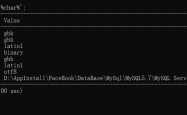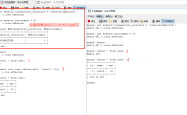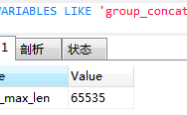Mysql巧用join优化sql的方法详解
0. 准备相关表来进行接下来的测试
相关建表语句请看:https://github.com/YangBaohust/my_sql
?| 1 2 3 4 5 6 7 8 9 10 11 12 13 14 15 16 17 18 19 20 21 22 23 24 25 26 27 28 29 30 31 32 33 34 35 36 37 38 39 40 41 42 43 44 45 46 47 | user1表,取经组 + ----+-----------+-----------------+---------------------------------+ | id | user_name | comment | mobile | + ----+-----------+-----------------+---------------------------------+ | 1 | 唐僧 | 旃檀功德佛 | 138245623,021-382349 | | 2 | 孙悟空 | 斗战胜佛 | 159384292,022-483432,+86-392432 | | 3 | 猪八戒 | 净坛使者 | 183208243,055-8234234 | | 4 | 沙僧 | 金身罗汉 | 293842295,098-2383429 | | 5 | NULL | 白龙马 | 993267899 | + ----+-----------+-----------------+---------------------------------+ user2表,悟空的朋友圈 + ----+--------------+-----------+ | id | user_name | comment | + ----+--------------+-----------+ | 1 | 孙悟空 | 美猴王 | | 2 | 牛魔王 | 牛哥 | | 3 | 铁扇公主 | 牛夫人 | | 4 | 菩提老祖 | 葡萄 | | 5 | NULL | 晶晶 | + ----+--------------+-----------+ user1_kills表,取经路上杀的妖怪数量 + ----+-----------+---------------------+-------+ | id | user_name | timestr | kills | + ----+-----------+---------------------+-------+ | 1 | 孙悟空 | 2013-01-10 00:00:00 | 10 | | 2 | 孙悟空 | 2013-02-01 00:00:00 | 2 | | 3 | 孙悟空 | 2013-02-05 00:00:00 | 12 | | 4 | 孙悟空 | 2013-02-12 00:00:00 | 22 | | 5 | 猪八戒 | 2013-01-11 00:00:00 | 20 | | 6 | 猪八戒 | 2013-02-07 00:00:00 | 17 | | 7 | 猪八戒 | 2013-02-08 00:00:00 | 35 | | 8 | 沙僧 | 2013-01-10 00:00:00 | 3 | | 9 | 沙僧 | 2013-01-22 00:00:00 | 9 | | 10 | 沙僧 | 2013-02-11 00:00:00 | 5 | + ----+-----------+---------------------+-------+ user1_equipment表,取经组装备 + ----+-----------+--------------+-----------------+-----------------+ | id | user_name | arms | clothing | shoe | + ----+-----------+--------------+-----------------+-----------------+ | 1 | 唐僧 | 九环锡杖 | 锦斓袈裟 | 僧鞋 | | 2 | 孙悟空 | 金箍棒 | 梭子黄金甲 | 藕丝步云履 | | 3 | 猪八戒 | 九齿钉耙 | 僧衣 | 僧鞋 | | 4 | 沙僧 | 降妖宝杖 | 僧衣 | 僧鞋 | + ----+-----------+--------------+-----------------+-----------------+ |
例子:找出取经组中不属于悟空朋友圈的人
?| 1 2 3 4 5 6 7 | + ----+-----------+-----------------+-----------------------+ | id | user_name | comment | mobile | + ----+-----------+-----------------+-----------------------+ | 1 | 唐僧 | 旃檀功德佛 | 138245623,021-382349 | | 3 | 猪八戒 | 净坛使者 | 183208243,055-8234234 | | 4 | 沙僧 | 金身罗汉 | 293842295,098-2383429 | + ----+-----------+-----------------+-----------------------+ |
not in写法:
?| 1 | select * from user1 a where a.user_name not in ( select user_name from user2 where user_name is not null ); |
left join写法:
首先看通过user_name进行连接的外连接数据集
?| 1 | select a.*, b.* from user1 a left join user2 b on (a.user_name = b.user_name); |
| 1 2 3 4 5 6 7 8 9 | + ----+-----------+-----------------+---------------------------------+------+-----------+-----------+ | id | user_name | comment | mobile | id | user_name | comment | + ----+-----------+-----------------+---------------------------------+------+-----------+-----------+ | 2 | 孙悟空 | 斗战胜佛 | 159384292,022-483432,+86-392432 | 1 | 孙悟空 | 美猴王 | | 1 | 唐僧 | 旃檀功德佛 | 138245623,021-382349 | NULL | NULL | NULL | | 3 | 猪八戒 | 净坛使者 | 183208243,055-8234234 | NULL | NULL | NULL | | 4 | 沙僧 | 金身罗汉 | 293842295,098-2383429 | NULL | NULL | NULL | | 5 | NULL | 白龙马 | 993267899 | NULL | NULL | NULL | + ----+-----------+-----------------+---------------------------------+------+-----------+-----------+ |
可以看到a表中的所有数据都有显示,b表中的数据只有b.user_name与a.user_name相等才显示,其余都以null值填充,要想找出取经组中不属于悟空朋友圈的人,只需要在b.user_name中加一个过滤条件b.user_name is null即可。
?| 1 | select a.* from user1 a left join user2 b on (a.user_name = b.user_name) where b.user_name is null ; |
| 1 2 3 4 5 6 7 8 | + ----+-----------+-----------------+-----------------------+ | id | user_name | comment | mobile | + ----+-----------+-----------------+-----------------------+ | 1 | 唐僧 | 旃檀功德佛 | 138245623,021-382349 | | 3 | 猪八戒 | 净坛使者 | 183208243,055-8234234 | | 4 | 沙僧 | 金身罗汉 | 293842295,098-2383429 | | 5 | NULL | 白龙马 | 993267899 | + ----+-----------+-----------------+-----------------------+ |
看到这里发现结果集中还多了一个白龙马,继续添加过滤条件a.user_name is not null即可。
?| 1 | select a.* from user1 a left join user2 b on (a.user_name = b.user_name) where b.user_name is null and a.user_name is not null ; |
2. 使用left join优化标量子查询
例子:查看取经组中的人在悟空朋友圈的昵称
?| 1 2 3 4 5 6 7 8 9 | + -----------+-----------------+-----------+ | user_name | comment | comment2 | + -----------+-----------------+-----------+ | 唐僧 | 旃檀功德佛 | NULL | | 孙悟空 | 斗战胜佛 | 美猴王 | | 猪八戒 | 净坛使者 | NULL | | 沙僧 | 金身罗汉 | NULL | | NULL | 白龙马 | NULL | + -----------+-----------------+-----------+ |
子查询写法:
?| 1 | select a.user_name, a.comment, ( select comment from user2 b where b.user_name = a.user_name) comment2 from user1 a; |
left join写法:
?| 1 | select a.user_name, a.comment, b.comment comment2 from user1 a left join user2 b on (a.user_name = b.user_name); |
3. 使用join优化聚合子查询
例子:查询出取经组中每人打怪最多的日期
?| 1 2 3 4 5 6 7 | + ----+-----------+---------------------+-------+ | id | user_name | timestr | kills | + ----+-----------+---------------------+-------+ | 4 | 孙悟空 | 2013-02-12 00:00:00 | 22 | | 7 | 猪八戒 | 2013-02-08 00:00:00 | 35 | | 9 | 沙僧 | 2013-01-22 00:00:00 | 9 | + ----+-----------+---------------------+-------+ |
聚合子查询写法:
?| 1 | select * from user1_kills a where a.kills = ( select max (b.kills) from user1_kills b where b.user_name = a.user_name); |
join写法:
首先看两表自关联的结果集,为节省篇幅,只取猪八戒的打怪数据来看
?| 1 | select a.*, b.* from user1_kills a join user1_kills b on (a.user_name = b.user_name) order by 1; |
| 1 2 3 4 5 6 7 8 9 10 11 12 13 | + ----+-----------+---------------------+-------+----+-----------+---------------------+-------+ | id | user_name | timestr | kills | id | user_name | timestr | kills | + ----+-----------+---------------------+-------+----+-----------+---------------------+-------+ | 5 | 猪八戒 | 2013-01-11 00:00:00 | 20 | 5 | 猪八戒 | 2013-01-11 00:00:00 | 20 | | 5 | 猪八戒 | 2013-01-11 00:00:00 | 20 | 6 | 猪八戒 | 2013-02-07 00:00:00 | 17 | | 5 | 猪八戒 | 2013-01-11 00:00:00 | 20 | 7 | 猪八戒 | 2013-02-08 00:00:00 | 35 | | 6 | 猪八戒 | 2013-02-07 00:00:00 | 17 | 7 | 猪八戒 | 2013-02-08 00:00:00 | 35 | | 6 | 猪八戒 | 2013-02-07 00:00:00 | 17 | 5 | 猪八戒 | 2013-01-11 00:00:00 | 20 | | 6 | 猪八戒 | 2013-02-07 00:00:00 | 17 | 6 | 猪八戒 | 2013-02-07 00:00:00 | 17 | | 7 | 猪八戒 | 2013-02-08 00:00:00 | 35 | 5 | 猪八戒 | 2013-01-11 00:00:00 | 20 | | 7 | 猪八戒 | 2013-02-08 00:00:00 | 35 | 6 | 猪八戒 | 2013-02-07 00:00:00 | 17 | | 7 | 猪八戒 | 2013-02-08 00:00:00 | 35 | 7 | 猪八戒 | 2013-02-08 00:00:00 | 35 | + ----+-----------+---------------------+-------+----+-----------+---------------------+-------+ |
可以看到当两表通过user_name进行自关联,只需要对a表的所有字段进行一个group by,取b表中的max(kills),只要a.kills=max(b.kills)就满足要求了。sql如下
?| 1 | select a.* from user1_kills a join user1_kills b on (a.user_name = b.user_name) group by a.id, a.user_name, a.timestr, a.kills having a.kills = max (b.kills); |
4. 使用join进行分组选择
例子:对第3个例子进行升级,查询出取经组中每人打怪最多的前两个日期
?| 1 2 3 4 5 6 7 8 9 10 | + ----+-----------+---------------------+-------+ | id | user_name | timestr | kills | + ----+-----------+---------------------+-------+ | 3 | 孙悟空 | 2013-02-05 00:00:00 | 12 | | 4 | 孙悟空 | 2013-02-12 00:00:00 | 22 | | 5 | 猪八戒 | 2013-01-11 00:00:00 | 20 | | 7 | 猪八戒 | 2013-02-08 00:00:00 | 35 | | 9 | 沙僧 | 2013-01-22 00:00:00 | 9 | | 10 | 沙僧 | 2013-02-11 00:00:00 | 5 | + ----+-----------+---------------------+-------+ |
在oracle中,可以通过分析函数来实现
?| 1 | select b.* from ( select a.*, row_number() over(partition by user_name order by kills desc ) cnt from user1_kills a) b where b.cnt <= 2; |
很遗憾,上面sql在mysql中报错ERROR 1064 (42000): You have an error in your SQL syntax; 因为mysql并不支持分析函数。不过可以通过下面的方式去实现。
首先对两表进行自关联,为了节约篇幅,只取出孙悟空的数据
?| 1 | select a.*, b.* from user1_kills a join user1_kills b on (a.user_name=b.user_name and a.kills<=b.kills) order by a.user_name, a.kills desc ; |
| 1 2 3 4 5 6 7 8 9 10 11 12 13 14 | + ----+-----------+---------------------+-------+----+-----------+---------------------+-------+ | id | user_name | timestr | kills | id | user_name | timestr | kills | + ----+-----------+---------------------+-------+----+-----------+---------------------+-------+ | 4 | 孙悟空 | 2013-02-12 00:00:00 | 22 | 4 | 孙悟空 | 2013-02-12 00:00:00 | 22 | | 3 | 孙悟空 | 2013-02-05 00:00:00 | 12 | 3 | 孙悟空 | 2013-02-05 00:00:00 | 12 | | 3 | 孙悟空 | 2013-02-05 00:00:00 | 12 | 4 | 孙悟空 | 2013-02-12 00:00:00 | 22 | | 1 | 孙悟空 | 2013-01-10 00:00:00 | 10 | 1 | 孙悟空 | 2013-01-10 00:00:00 | 10 | | 1 | 孙悟空 | 2013-01-10 00:00:00 | 10 | 3 | 孙悟空 | 2013-02-05 00:00:00 | 12 | | 1 | 孙悟空 | 2013-01-10 00:00:00 | 10 | 4 | 孙悟空 | 2013-02-12 00:00:00 | 22 | | 2 | 孙悟空 | 2013-02-01 00:00:00 | 2 | 1 | 孙悟空 | 2013-01-10 00:00:00 | 10 | | 2 | 孙悟空 | 2013-02-01 00:00:00 | 2 | 3 | 孙悟空 | 2013-02-05 00:00:00 | 12 | | 2 | 孙悟空 | 2013-02-01 00:00:00 | 2 | 4 | 孙悟空 | 2013-02-12 00:00:00 | 22 | | 2 | 孙悟空 | 2013-02-01 00:00:00 | 2 | 2 | 孙悟空 | 2013-02-01 00:00:00 | 2 | + ----+-----------+---------------------+-------+----+-----------+---------------------+-------+ |
从上面的表中我们知道孙悟空打怪前两名的数量是22和12,那么只需要对a表的所有字段进行一个group by,对b表的id做个count,count值小于等于2就满足要求,sql改写如下:
?| 1 | select a.* from user1_kills a join user1_kills b on (a.user_name=b.user_name and a.kills<=b.kills) group by a.id, a.user_name, a.timestr, a.kills having count (b.id) <= 2; |
5. 使用笛卡尔积关联实现一列转多行
例子:将取经组中每个电话号码变成一行
原始数据:
?| 1 2 3 4 5 6 7 8 9 | + -----------+---------------------------------+ | user_name | mobile | + -----------+---------------------------------+ | 唐僧 | 138245623,021-382349 | | 孙悟空 | 159384292,022-483432,+86-392432 | | 猪八戒 | 183208243,055-8234234 | | 沙僧 | 293842295,098-2383429 | | NULL | 993267899 | + -----------+---------------------------------+ |
想要得到的数据:
?| 1 2 3 4 5 6 7 8 9 10 11 12 13 14 | + -----------+-------------+ | user_name | mobile | + -----------+-------------+ | 唐僧 | 138245623 | | 唐僧 | 021-382349 | | 孙悟空 | 159384292 | | 孙悟空 | 022-483432 | | 孙悟空 | +86-392432 | | 猪八戒 | 183208243 | | 猪八戒 | 055-8234234 | | 沙僧 | 293842295 | | 沙僧 | 098-2383429 | | NULL | 993267899 | + -----------+-------------+ |
可以看到唐僧有两个电话,因此他就需要两行。我们可以先求出每人的电话号码数量,然后与一张序列表进行笛卡儿积关联,为了节约篇幅,只取出唐僧的数据
?| 1 | select a.id, b.* from tb_sequence a cross join ( select user_name, mobile, length(mobile)-length( replace (mobile, ',' , '' ))+1 size from user1) b order by 2,1; |
| 1 2 3 4 5 6 7 8 9 10 11 12 13 14 | + ----+-----------+---------------------------------+------+ | id | user_name | mobile | size | + ----+-----------+---------------------------------+------+ | 1 | 唐僧 | 138245623,021-382349 | 2 | | 2 | 唐僧 | 138245623,021-382349 | 2 | | 3 | 唐僧 | 138245623,021-382349 | 2 | | 4 | 唐僧 | 138245623,021-382349 | 2 | | 5 | 唐僧 | 138245623,021-382349 | 2 | | 6 | 唐僧 | 138245623,021-382349 | 2 | | 7 | 唐僧 | 138245623,021-382349 | 2 | | 8 | 唐僧 | 138245623,021-382349 | 2 | | 9 | 唐僧 | 138245623,021-382349 | 2 | | 10 | 唐僧 | 138245623,021-382349 | 2 | + ----+-----------+---------------------------------+------+ |
a.id对应的就是第几个电话号码,size就是总的电话号码数量,因此可以加上关联条件(a.id <= b.size),将上面的sql继续调整
?| 1 | select b.user_name, replace ( substring (substring_index(b.mobile, ',' , a.id), char_length(substring_index(mobile, ',' , a.id-1)) + 1), ',' , '' ) as mobile from tb_sequence a cross join ( select user_name, concat(mobile, ',' ) as mobile, length(mobile)-length( replace (mobile, ',' , '' ))+1 size from user1) b on (a.id <= b. size ); |
6. 使用笛卡尔积关联实现多列转多行
例子:将取经组中每件装备变成一行
原始数据:
?| 1 2 3 4 5 6 7 8 | + ----+-----------+--------------+-----------------+-----------------+ | id | user_name | arms | clothing | shoe | + ----+-----------+--------------+-----------------+-----------------+ | 1 | 唐僧 | 九环锡杖 | 锦斓袈裟 | 僧鞋 | | 2 | 孙悟空 | 金箍棒 | 梭子黄金甲 | 藕丝步云履 | | 3 | 猪八戒 | 九齿钉耙 | 僧衣 | 僧鞋 | | 4 | 沙僧 | 降妖宝杖 | 僧衣 | 僧鞋 | + ----+-----------+--------------+-----------------+-----------------+ |
想要得到的数据:
?| 1 2 3 4 5 6 7 8 9 10 11 12 13 14 15 16 | + -----------+-----------+-----------------+ | user_name | equipment | equip_mame | + -----------+-----------+-----------------+ | 唐僧 | arms | 九环锡杖 | | 唐僧 | clothing | 锦斓袈裟 | | 唐僧 | shoe | 僧鞋 | | 孙悟空 | arms | 金箍棒 | | 孙悟空 | clothing | 梭子黄金甲 | | 孙悟空 | shoe | 藕丝步云履 | | 沙僧 | arms | 降妖宝杖 | | 沙僧 | clothing | 僧衣 | | 沙僧 | shoe | 僧鞋 | | 猪八戒 | arms | 九齿钉耙 | | 猪八戒 | clothing | 僧衣 | | 猪八戒 | shoe | 僧鞋 | + -----------+-----------+-----------------+ |
union的写法:
?| 1 2 3 4 5 6 | select user_name, 'arms' as equipment, arms equip_mame from user1_equipment union all select user_name, 'clothing' as equipment, clothing equip_mame from user1_equipment union all select user_name, 'shoe' as equipment, shoe equip_mame from user1_equipment order by 1, 2; |
join的写法:
首先看笛卡尔数据集的效果,以唐僧为例
?| 1 | select a.*, b.* from user1_equipment a cross join tb_sequence b where b.id <= 3; |
| 1 2 3 4 5 6 7 | + ----+-----------+--------------+-----------------+-----------------+----+ | id | user_name | arms | clothing | shoe | id | + ----+-----------+--------------+-----------------+-----------------+----+ | 1 | 唐僧 | 九环锡杖 | 锦斓袈裟 | 僧鞋 | 1 | | 1 | 唐僧 | 九环锡杖 | 锦斓袈裟 | 僧鞋 | 2 | | 1 | 唐僧 | 九环锡杖 | 锦斓袈裟 | 僧鞋 | 3 | + ----+-----------+--------------+-----------------+-----------------+----+ |
使用case对上面的结果进行处理
?| 1 2 3 4 5 6 7 8 | select user_name, case when b.id = 1 then 'arms' when b.id = 2 then 'clothing' when b.id = 3 then 'shoe' end as equipment, case when b.id = 1 then arms end arms, case when b.id = 2 then clothing end clothing, case when b.id = 3 then shoe end shoe from user1_equipment a cross join tb_sequence b where b.id <=3; |
| 1 2 3 4 5 6 7 | + -----------+-----------+--------------+-----------------+-----------------+ | user_name | equipment | arms | clothing | shoe | + -----------+-----------+--------------+-----------------+-----------------+ | 唐僧 | arms | 九环锡杖 | NULL | NULL | | 唐僧 | clothing | NULL | 锦斓袈裟 | NULL | | 唐僧 | shoe | NULL | NULL | 僧鞋 | + -----------+-----------+--------------+-----------------+-----------------+ |
使用coalesce函数将多列数据进行合并
?| 1 2 3 4 5 6 7 8 | select user_name, case when b.id = 1 then 'arms' when b.id = 2 then 'clothing' when b.id = 3 then 'shoe' end as equipment, coalesce ( case when b.id = 1 then arms end , case when b.id = 2 then clothing end , case when b.id = 3 then shoe end ) equip_mame from user1_equipment a cross join tb_sequence b where b.id <=3 order by 1, 2; |
7. 使用join更新过滤条件中包含自身的表
例子:把同时存在于取经组和悟空朋友圈中的人,在取经组中把comment字段更新为"此人在悟空的朋友圈"
我们很自然地想到先查出user1和user2中user_name都存在的人,然后更新user1表,sql如下
?| 1 | update user1 set comment = '此人在悟空的朋友圈' where user_name in ( select a.user_name from user1 a join user2 b on (a.user_name = b.user_name)); |
很遗憾,上面sql在mysql中报错:ERROR 1093 (HY000): You can't specify target table 'user1' for update in FROM clause,提示不能更新目标表在from子句的表。
那有没有其它办法呢?我们可以将in的写法转换成join的方式
?| 1 | select c.*, d.* from user1 c join ( select a.user_name from user1 a join user2 b on (a.user_name = b.user_name)) d on (c.user_name = d.user_name); |
| 1 2 3 4 5 | + ----+-----------+--------------+---------------------------------+-----------+ | id | user_name | comment | mobile | user_name | + ----+-----------+--------------+---------------------------------+-----------+ | 2 | 孙悟空 | 斗战胜佛 | 159384292,022-483432,+86-392432 | 孙悟空 | + ----+-----------+--------------+---------------------------------+-----------+ |
然后对join之后的视图进行更新即可
?| 1 | update user1 c join ( select a.user_name from user1 a join user2 b on (a.user_name = b.user_name)) d on (c.user_name = d.user_name) set c.comment = '此人在悟空的朋友圈' ; |
再查看user1,可以看到user1已修改成功
?| 1 | select * from user1; |
| 1 2 3 4 5 6 7 8 9 | + ----+-----------+-----------------------------+---------------------------------+ | id | user_name | comment | mobile | + ----+-----------+-----------------------------+---------------------------------+ | 1 | 唐僧 | 旃檀功德佛 | 138245623,021-382349 | | 2 | 孙悟空 | 此人在悟空的朋友圈 | 159384292,022-483432,+86-392432 | | 3 | 猪八戒 | 净坛使者 | 183208243,055-8234234 | | 4 | 沙僧 | 金身罗汉 | 293842295,098-2383429 | | 5 | NULL | 白龙马 | 993267899 | + ----+-----------+-----------------------------+---------------------------------+ |
8. 使用join删除重复数据
首先向user2表中插入两条数据
?| 1 2 | insert into user2(user_name, comment) values ( '孙悟空' , '美猴王' ); insert into user2(user_name, comment) values ( '牛魔王' , '牛哥' ); |
例子:将user2表中的重复数据删除,只保留id号大的
?| 1 2 3 4 5 6 7 8 9 10 11 | + ----+--------------+-----------+ | id | user_name | comment | + ----+--------------+-----------+ | 1 | 孙悟空 | 美猴王 | | 2 | 牛魔王 | 牛哥 | | 3 | 铁扇公主 | 牛夫人 | | 4 | 菩提老祖 | 葡萄 | | 5 | NULL | 晶晶 | | 6 | 孙悟空 | 美猴王 | | 7 | 牛魔王 | 牛哥 | + ----+--------------+-----------+ |
首先查看重复记录
?| 1 | select a.*, b.* from user2 a join ( select user_name, comment, max (id) id from user2 group by user_name, comment having count (*) > 1) b on (a.user_name=b.user_name and a.comment=b.comment) order by 2; |
| 1 2 3 4 5 6 7 8 | + ----+-----------+-----------+-----------+-----------+------+ | id | user_name | comment | user_name | comment | id | + ----+-----------+-----------+-----------+-----------+------+ | 1 | 孙悟空 | 美猴王 | 孙悟空 | 美猴王 | 6 | | 6 | 孙悟空 | 美猴王 | 孙悟空 | 美猴王 | 6 | | 2 | 牛魔王 | 牛哥 | 牛魔王 | 牛哥 | 7 | | 7 | 牛魔王 | 牛哥 | 牛魔王 | 牛哥 | 7 | + ----+-----------+-----------+-----------+-----------+------+ |
接着只需要删除(a.id < b.id)的数据即可
?| 1 | delete a from user2 a join ( select user_name, comment, max (id) id from user2 group by user_name, comment having count (*) > 1) b on (a.user_name=b.user_name and a.comment=b.comment) where a.id < b.id; |
查看user2,可以看到重复数据已经被删掉了
?| 1 | select * from user2; |
| 1 2 3 4 5 6 7 8 9 | + ----+--------------+-----------+ | id | user_name | comment | + ----+--------------+-----------+ | 3 | 铁扇公主 | 牛夫人 | | 4 | 菩提老祖 | 葡萄 | | 5 | NULL | 晶晶 | | 6 | 孙悟空 | 美猴王 | | 7 | 牛魔王 | 牛哥 | + ----+--------------+-----------+ |
总结:
给大家就介绍到这里,大家有兴趣可以多造点数据,然后比较不同的sql写法在执行时间上的区别。本文例子取自于慕课网《sql开发技巧》。
好了,以上就是这篇文章的全部内容了,希望本文的内容对大家的学习或者工作具有一定的参考学习价值,谢谢大家对服务器之家的支持。
原文链接:https://www.cnblogs.com/ddzj01/p/11346954.html
1.本站遵循行业规范,任何转载的稿件都会明确标注作者和来源;2.本站的原创文章,请转载时务必注明文章作者和来源,不尊重原创的行为我们将追究责任;3.作者投稿可能会经我们编辑修改或补充。











